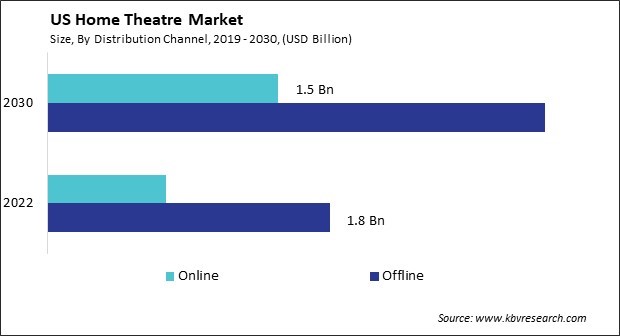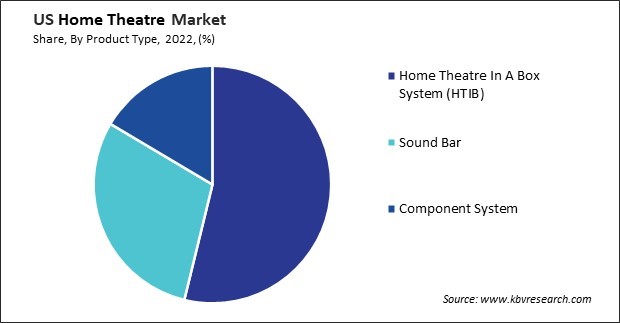Int'l : +1(646) 832-2886 | query@kbvresearch.com
Int'l : +1(646) 832-2886 | query@kbvresearch.com
Published Date : 15-Jul-2024 |
Pages: 93 |
Formats: PDF |
The US Home Theatre Market size is expected to reach $4.7 billion by 2030, rising at a market growth of 7.8% CAGR during the forecast period. In the year 2022, the market attained a volume of 6,087.9 Thousand Units, experiencing a growth of 7.5% (2019-2022).
The home theatre market in the United States has witnessed significant growth over the past few decades, fueled by advancements in technology, changing consumer preferences, and the increasing desire for immersive entertainment experiences within the comfort of one's home. One of the key drivers of the home theatre market's growth is the continuous innovation in audiovisual technologies. Furthermore, the availability of larger screen sizes, such as 4K and 8K televisions, has elevated the viewing experience to new heights, making home theatres more appealing to consumers who seek immersive entertainment.

Another factor fueling the growth of the home theatre market in the U.S. is the rapid advancement of technology. From high-definition televisions to surround sound systems and smart home integration, home theatre systems offer an immersive and customizable experience that rivals that of commercial cinemas. Innovations such as 4K resolution, HDR (High Dynamic Range), and Dolby Atmos sound have become standard features in many home theatre setups, providing American with stunning visuals and audio quality.
Moreover, the proliferation of streaming services has transformed how U.S. consumers access and consume content in their home theatres. Subscription-based platforms like Netflix, Amazon Prime Video, and Disney+ offer a vast library of movies, TV series, and original content, eliminating the need for physical media and providing instant access to a diverse range of entertainment options. The convenience of streaming and the availability of high-speed internet connectivity have made home theatres more accessible and appealing to a broader audience.
The COVID-19 pandemic has also influenced the dynamics of the home theatre market in the U.S., accelerating the adoption of home entertainment solutions as Americans spend more time indoors. With restrictions on public gatherings and the temporary closure of cinemas, many U.S. consumers turned to home theatres as a safe and convenient alternative for enjoying movies and other forms of entertainment.
The convergence of mobile gaming and home theatre technology has sparked a revolution in the entertainment landscape, particularly in the United States. With the widespread adoption of smartphones and tablets and advancements in home theatre systems, Americans are increasingly embracing the idea of transforming their living rooms into immersive gaming environments. The surge in demand for video games during the pandemic has significantly boosted sales in the U.S.
According to the International Trade Administration, the U.S. sees a record 31% increase in consumer spending on video gaming and subscription services. Notably, the popularity of mobile gaming has soared, evidenced by a substantial 13.3% increase in revenue, reaching $77.2 billion in 2020. This trend reflects the growing preference for mobile gaming experiences even within the home theatre market in the U.S.
One of the key drivers behind the growing popularity of mobile gaming in the home theatre market is the convenience and accessibility of mobile devices. As a result, U.S. consumers are increasingly turning to mobile devices as their primary gaming platforms, even within the confines of their home theatres.
Another factor driving the popularity of mobile gaming in the home theatre market is the social aspect of gaming. Many mobile games feature multiplayer modes or social features that allow players to connect with friends. When played on the big screen in a home theatre setting, these multiplayer experiences become even more dynamic and immersive, fostering a sense of camaraderie and competition among players. Hence, mobile gaming and home theatre technology convergence is reshaping the entertainment landscape, with U.S. consumers embracing immersive experiences and social connectivity within their living rooms.
The home theatre market in the U.S. is experiencing a notable surge in demand for voice recognition and AI assistants, reshaping how consumers interact with their entertainment systems. One significant driver behind the increasing demand for voice recognition and AI assistants in home theatre is the widespread adoption of smart home devices. Americans increasingly turn to connected devices to enhance their living spaces, and home theatre systems are no exception. By incorporating voice recognition technology, users in the U.S. control various aspects of their entertainment experience hands-free, whether it's adjusting the volume, changing the channel, or searching for content.
Furthermore, advancements in AI technology have significantly improved the capabilities of voice recognition systems and AI assistants. Today's AI assistants, such as Amazon's Alexa, Google Assistant, and Apple's Siri, boast sophisticated natural language processing algorithms that enable more accurate voice commands and responses. These AI assistants also learn user preferences over time, providing personalized recommendations for movies, music, and TV shows.
The demand for voice recognition and AI assistants in the home theatre market is driven by the desire for seamless integration and convenience. Americans increasingly seek interconnected entertainment ecosystems that allow them to control all aspects of their home theatre experience from a single interface. Thus, the surge in demand for voice recognition and AI assistants in the U.S. home theatre market reflects a growing desire for seamless integration and convenience in entertainment systems.

The home theatre market in the United States is a dynamic and competitive industry driven by technological advancements, changing consumer preferences, and growing demand for immersive entertainment experiences in the comfort of one's home. One of the key players in the U.S. home theatre market is Sony Corporation. Renowned for its cutting-edge audiovisual technology, Sony offers a comprehensive range of home theatre systems, including high-definition televisions, surround sound speakers, and Blu-ray players. With a focus on innovation and quality, Sony continues to captivate consumers with its state-of-the-art products that deliver unparalleled audio and visual experiences.
Another prominent contender in the U.S. home theatre market is LG Electronics, known for its innovative approach to home entertainment. From sleek OLED TVs to immersive Dolby Atmos sound systems, LG offers various products to elevate the home viewing experience. With a focus on user-friendly features and sleek, modern design, LG continues to attract discerning consumers seeking the ultimate in-home theatre technology.
In addition to these industry giants, numerous niche players and startups are making waves in the U.S. home theatre market. Companies like Sonos specialize in wireless audio systems, offering consumers a seamless and customizable solution for multi-room audio playback. Meanwhile, brands like Vizio have gained traction by providing high-quality home theatre products at competitive prices, catering to budget-conscious consumers without sacrificing performance or features.
The U.S. home theatre market also sees increased competition from streaming media companies such as Roku and Amazon. These companies offer streaming devices and smart TVs that provide access to a vast array of streaming services, allowing consumers to easily enjoy their favorite movies, TV shows, and music. With the growing popularity of streaming platforms, these companies play a significant role in shaping the future of home entertainment.
Furthermore, the rise of smart home technology has led to integrating home theatre systems with voice assistants like Amazon Alexa and Google Assistant. Companies like Bose and Yamaha have embraced this trend, offering smart speakers and soundbars that seamlessly integrate with popular voice platforms, allowing users to control their home theatre experience with simple voice commands. As technology evolves and consumer preferences shift, companies must stay ahead of the curve to remain competitive in this dynamic and ever-changing industry.
By Distribution Channel
By Product Type